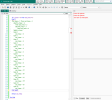Hello everybody
I try create a sub routine that compare one variable (for example 1 to 10) and when variable are good , then variable as char assigned with a character
Example :
variable = 2 char variable assign W
variable = 3 char variable assign F
variable = 4 char variable assign R
etc ...
i learn beginner guide >> Subs / routines , case - select, if then else. I try some codes, but B4A ide often gives me errors that I don't understand. Also I find that the examples of the manual are short. How do we analyze for example 4 values ? How initialize variables in sub routine ?
Thank
I try create a sub routine that compare one variable (for example 1 to 10) and when variable are good , then variable as char assigned with a character
Example :
variable = 2 char variable assign W
variable = 3 char variable assign F
variable = 4 char variable assign R
etc ...
i learn beginner guide >> Subs / routines , case - select, if then else. I try some codes, but B4A ide often gives me errors that I don't understand. Also I find that the examples of the manual are short. How do we analyze for example 4 values ? How initialize variables in sub routine ?
Thank

